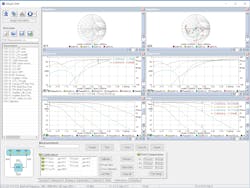Download this article as a .PDF
Vector network analyzers (VNAs) are essential test instruments for firms that need to characterize RF/microwave components. However, fully equipped, rack-mounted VNA systems can carry hefty price tags. Fortunately, the economical VNA-0440 and VNA-0460 VNAs from MegiQ provide two-port bidirectional VNA measurements from 400 MHz to 4 and 6 GHz, respectively, and at a fraction of the cost of full-sized VNA systems.
These VNAs are based on an innovative architecture, and leverage the processing power of an external PC running Windows XP through 10 and dedicated software. They deliver highly accurate, calibrated, 12-term, error-corrected S-parameter measurements on active and passive devices under test (DUTs).
The VNA-0440 and VNA-0460 VNAs (Fig. 1) are ruggedly built with two SMA test ports for making two-port S-parameter measurements, such as S11, S21, S12, and S22. The measurement ports are fully calibrated at the factory for direct measurements on suitable DUTs with an SMA connector. For measurements involving coaxial cables and connectors or on-board connectors, the VNAs are supplied with measurement software that guides an operator through a reliable short-open-load-through (SOLT) calibration process. With their dedicated software, the compact VNAs can make swept-parameter measurements with as many as 20,000 data points.
The VNAs feature internal test-signal generators covering their respective frequency ranges and capable of power level adjustments from −30 to +5 dBm with ±1 dB accuracy and 0.5-dB power adjustment resolution. The test signals are quite clean, with harmonic levels of less than −35 dBc.
The VNAs are equipped with wide-dynamic-range detectors for measuring a DUT’s port power, with ranges of −75 to +20 dBm from 400 MHz to 4 GHz and −60 to +20 dBm from 4 to 6 GHz. The detectors are supported by an input attenuator with attenuation range of 0 to 30 dB, as might be used for measuring higher-power DUTs, such as amplifiers.
Versions of the VNAs are available as models VNA-0440e and VNA-0460e which also operate from 400 MHz to 4 and 6 GHz, respectively, but these are 2.5-port bidirectional VNAs which also provide measurements of S13 and S23. In addition, they include a signal generator output port, as well as a precision bias generator for powering active devices (such as transistors and amplifiers). It provides a voltage range of −12 to +12 V dc and a current range of 0 to 100 mA.
The compact VNAs are operated by means of intuitive measurement software, which shows test results on a PC screen in various formats, including on Smith charts and as x-y plots (Fig. 2). The software, which was written for use with a computer having a touchscreen, includes several preset routines for quickly and automatically performing regular and routine one- and two-port measurements, such as insertion loss, insertion gain, phase, and group delay.
The software includes a sweep manager that allows an operator to combine multiple measurement parameters, such as frequency, power, and bias, into a parametric sweep. For antenna tuning and matching, the software also features a handy match calculator that provides circuits designed to match 50 Ω to a specific impedance point on a Smith chart.
The test software incorporates a Session Manager that allows an operator to store several measurements in a session file. This way, it is possible to follow a trail of measurements and reconstruct a measurement strategy. All calibration and measurement data are stored, enabling a user to return to an earlier measurement and use that test setup for additional measurements.
For large-scale automated measurements, an Application Programming Interface (API) is available to use these VNAs with the major measurement programs, including Visual Basic (VB) from Microsoft, LabVIEW from National Instruments, and C++ programming language.
For those seeking to explore the capabilities of their compact VNAs, the VNA Sandbox is a circuit board constructed with many different experiments. It contains many different one- and two-port circuits for testing, including antennas, filters, and amplifiers, and all the adapters and connectors needed for making measurements with one of the VNAs. It is supplied with an extensive tutorial lesson on calibration and VNA measurements to help someone get started on making RF/microwave active and passive S-parameter measurements.
VNA kits supplied with the VNA Sandbox greatly simplify PC-based RF/microwave test development. It helps make these VNAs attractive additions to the test capabilities of small and large companies alike.
MegiQ BV, Weegschaalstraat 3, 5632CW Eindhoven, The Netherlands; +31-40-2911479



